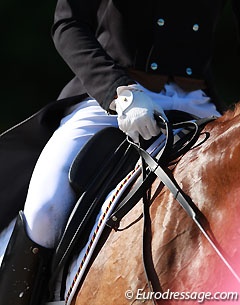
I have had many arguments with people who believe that Nuno Oliveira rode without a contact. This is incorrect. In fact, he was one of the true geniuses of Equestrian Art who could somehow maintain a connection to the horse's mouth, with his reins in loops. I have often seen riders try to recreate this image and end up plopping around with the reins in loops and the horse on the forehand. While Nuno himself could achieve this elastic connection, he never instructed his pupils to do the same, saying that to give the rein or yield, was not to abandon the horse.
“The rider who leaves a horse on his own in the name of lightness is not working but is just strolling with his horse. The one who pushes and pulls is a wild person,” said Nuno Oliveira.
In order to be a fair but effective rider we must walk the fine line between these two examples; a rider who can ask, release, and retake without dropping the contact and without pulling on the horse's mouth. This of course, is not easy and is at the heart of most problems riders face in training. Either they take with too much force, or they give too quickly, dropping and then pulling the horse in what Nuno terms “Wild” dressage.
So how do you develop that sense of feel to be in the middle? Nuno refers to the ability to take and give the rein, to establish as elastic feel on the horse's mouth, as merely the ability to open and close the fingers, saying that “the small and ring fingers can yield but never the thumb." This means that the release and the close is so subtle, that we eliminate the habit of forceful rein aids and teach the horse to yield to the very delicate changes in our finger position.
Of course this doesn’t happen over night. It takes patience, work, and above all else, feeling! If you close the fingers and your horse does not respond, you must reinforce the aid and then ask again more subtly, just as you do with a light leg aid. In this way you teach the horse that he must yield to a very gentle rein aid, and then of course, you must yield the second that he does.
“In the art of riding, any excuse to yield is justified," Oliveira stated.
In the beginning the yield can be exaggerated until the horse understands that this is what you want, until one day the horse is so light and submissive that you very rarely need to close the fingers at all. “When riding a well trained horse, the fingers should only very rarely close," said Oliveira.
Again, this takes work. Some days it feels like you have gone back ten steps and the horse is not understanding anything you are saying. It’s good in these moments to stop. Halt. Wait. And while halted, gently open and close the fingers asking the horse to yield. Close the fingers on the left hand and gently allowing with the right asking him to flex left. Then the opposite. Teach the horse what you want and then reward him the minute you get what you want. Then work on the same principles at the trot, then canter, until you can flex and bend the horse without the need to pull or drop the rein completely.
Dressage is art because it is delicate. This means it takes 100 times the mental strength, that it ever should the physical!
by Sarah Warne